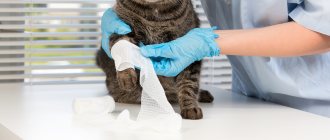Cats, by nature, although small, are predators. Anything that moves can become their prey. Therefore, they hunt not only mice and birds, but also insects. As a result, a situation may arise where a bee stings a cat.
Many animals tolerate this calmly, but sensitive pets may develop anaphylactic shock.
Signs and symptoms
Playing with a bee often ends in a sting. Cats, like people, react negatively to poison entering their body. Standard symptoms include:
- slight swelling or severe swelling at the site of the bite;
- redness;
- itching that the cat tries to relieve by scratching itself with its claws;
- painful sensations.
Swelling
If the lesion is minor, the signs of the bite will go away on their own after a few days, when the toxin is completely eliminated from the body. But it is better to immediately examine your pet to determine exactly where the bee stung the cat. This will help ease his suffering.
- Most often it affects the nose, which immediately swells. In this situation, it is not advisable to wait several days. Due to the swollen spot, the cat can not only eat normally, but also has difficulty breathing.
- The pet may also have difficulty breathing if the bite is on the cheek. The cat begins to wheeze, his heartbeat quickens, and chills appear. The animal feels weak.
- If you notice that your pet is limping, you need to examine its paw. Perhaps this is where the sting got stuck when the cat tried to swat the bee. The animal will try to get rid of the needle by licking the bite site with its tongue. These actions are accompanied by a plaintive meow.
- A cat experiences severe pain when a sting hits its lip. At the same time, it swells, the swelling quickly spreads to the entire muzzle, which becomes disproportionate. To relieve unpleasant symptoms, the animal tries to press its lip against something cold.
- The most dangerous situation is when a bee gets into the oral cavity and stings the cat on the tongue or larynx. The toxin immediately provokes swelling of the nasopharynx, and this swelling causes severe shortness of breath. In this situation, notable signs are excessive salivation and vomiting.
The more toxin that enters the cat’s body, the stronger all these symptoms will appear. Here it is important to provide timely assistance so that serious complications do not arise.
“Cat scratch disease” really exists!
Infections don't just come from cat bites, they can also come from cat scratches, causing an infection known as cat scratch disease. Approximately 40% of cats are infected with the bacteria Bartonella henselae, which they contract from flea bites and their droppings. When a cat scratches a person, B. henselae can enter the scratch and cause a localized skin infection as well as an infection that spreads to the lymph nodes located near the scratch. Symptoms of cat scratch disease may include: fever, fatigue, decreased appetite and headaches. Fortunately, cat scratch fever is rarely fatal, and symptoms are usually mild. The illness usually lasts from one to two weeks, although in some cases it has been known to take up to eight weeks. Symptoms usually go away on their own, but people with medical conditions may need medical attention.
First aid
If a bee stings, its sting remains in the body. The slightest touch to it increases the pain. Therefore, it is so important to locate the bite site and remove the sting from the cat.
This must be done extremely carefully, otherwise the sting will break and its poisoned tip will remain under the skin. In this case, it is more difficult to remove the fragment. You may even need surgery.
The place where the cat was bitten by a bee is treated with an antiseptic. This will help reduce inflammation. A cold compress is then applied to the swollen area.
Antiseptic
Prevention
Prevention of bee stings can only be done by protecting your home - mosquito nets on windows, nets on doors. Animal bowls should not be placed outside.
And, of course, pets must be closely monitored and treated with repellents.
Most often, a bee sting does not pose a danger to a cat; the symptoms go away within a few days, but the location of the poison causes great suffering to the pet. If the animal has been bitten by bees before and has not had any allergic reactions, then the cat will tolerate another bite well.
A big purring hello to everyone!
Summer, oh summer!!! Summer drives me crazy! There are all sorts of insects flying around, buzzing in your ear, and you really want to catch them and taste them.
It's a pity that they still have wings (((
Did you know that cats can have an allergic reaction to insect bites? A?
Do you know what to do if
your
cat bitten
, for example,
by a bee
?
Find out about it soon!
Sorry that I immediately scared you with allergies, but what to do? We need to fully understand the issue of bites.
For most cats, bites from ants, bees, hornets, wasps and spiders cause only an external reaction, i.e. swelling or blister.
But on some cats, such bites can make such an “indelible impression” that they can fall into a state of shock and begin to behave quite strangely: rushing around the house, yelling or hissing. Wait a couple of minutes: if the cat does not calm down, you should immediately consult a doctor, especially if, in addition to excitement, any of the following symptoms appear:
Prostration;
Excessive salivation;
Pupil dilation;
Rapid pulse.
If you wait a long time for the doctor, then you yourself will need to provide first aid to your tailed and mustachioed pet (pet). Give your cat a tablet of Tavegil, Suprastin, or another anti-allergic drug.
If the cat has become lethargic, then pour lukewarm strong black tea into his or her mouth (as much as possible) and go to the doctor.
If a cat is bitten by a bee
, wasp, or bumblebee, then first you will need to remove the remaining sting from the wound. To do this, use tweezers, a thin knife, or a scalpel pre-treated with an alcohol-containing liquid.
Take your time, be careful!
Then treat the affected area with hydrogen peroxide (if you don’t have it on the farm, use highly diluted vinegar).
An excellent anti-inflammatory effect is achieved by applying Gamabiol ointment.
A bag with several pieces of ice (frozen meat/vegetables) tied to the wound, or a “compress” made from a tea bag soaked in warm water, can also help relieve itching on the skin from a bite.
Yes, and don’t forget about the anti-allergen tablet again.
And now you will be very surprised, my dear friends, when you find out that a mosquito bite can sometimes cause the formation of ulcers on a cat’s skin.
It turns out that mosquito saliva is full of allergens (who would have thought that these little vampires even have saliva). Mosquitoes love to bite cats on their cute faces, ears, between their toes and pads. So, do not leave cats outside among mosquitoes for long periods of time.
If the kitty was at the dacha for the first time or was on a walk for the first time, then be sure to examine her after that for the presence of swelling and blisters.
As I already said, in particularly sensitive cats, mosquito bites can cause ulcers on the skin.
An injection with a drug such as dexafort in a dosage of 0.2 ml helps quite quickly against this.
Now you know everything about what to do if
Your
cat was bitten by a bee
or some other harmful insect.
I wish you, your family, your beloved cats and cats only the right bees, and that there are as few blood-sucking insects in your life as possible!
Your black happy cat Jose Carreras, with love at la-murmur.ru.
PS: The article is the property of the site site
When copying any materials, AN ACTIVE LINK TO THE SITE IS REQUIRED!
If a cat is stung by a bee, it is necessary to provide first aid and then act according to the circumstances. If your pet's health worsens, you should show it to a veterinarian. The most dangerous bites are on the muzzle, neck, and nose. If a severe allergic reaction develops, the animal risks dying.
Treatment with drugs
For minor lesions, local prevention can be carried out at home using pharmaceutical and folk remedies.
Ointments
To treat cats bitten by bees, medications are chosen based on the degree of damage:
- for minor bites, it is enough to treat the soft tissues with creams based on medicinal herbs (Menovazin, Bepanten, Zvezdochka);
- for moderate severity, you will need Fenistil gel;
- if the signs have become more pronounced, then it is no longer possible to do without deep penetration drugs that have an antiallergic effect (Betamethasone, Advantan, Elokom, Triaccutane).
When the bite results in infection entering the wound, you will need antibiotic ointments - Erythromycin, Gentamicin, Tetracycline, Levomekol.
Note! Ointments are applied to all external areas except the lips. The pet will quickly lick the medicine from them.
Fenistil
Folk remedies
You can also alleviate the suffering of a bitten cat using available means. In the absence of alcohol or hydrogen peroxide, it is recommended to treat the wound with soda slurry. The following recipes also help:
- Soap solution, infusion of sea buckthorn, chamomile, and calendula have a calming effect;
- Pieces of apple, orange (grapefruit) applied to the wound will help relieve irritation;
- You can calm itching and pain with the help of oat lotions;
- swelling will be removed with water acidified with lemon or vinegar;
- inflammation can be relieved with an aqueous solution of turmeric.
Folk remedies are effective when bees bite a cat on the paw or body. If the lesion is on the face, then this method of treatment will only temporarily relieve the animal’s suffering.
Disinfestation products
You can treat the wound if a bee has stung a cat with medical alcohol, ammonia, any alcohol tincture, or hydrogen peroxide.
- Tincture of valerian, motherwort, and calendula soothes pain and relieves swelling. A small amount is applied to a cotton swab and applied to the sore spot.
- If there is no alcohol, prepare a paste from soda. Mix kitchen salt and baking soda in equal proportions, dilute with a little water to form a paste. Apply to the skin. Baking soda helps relieve swelling, pain, burning, itching.
- You can disinfect the wound with juice from orange, lemon, onion, and potato. Another effective remedy is laundry soap or an acidic solution. Table vinegar and citric acid are added to the water. They make lotions, apply a compress, wipe the skin.
In the future, to eliminate swelling, decoctions of medicinal herbs are used - chamomile, mint, lemon balm, calendula. The potion is poured with boiling water and left for half an hour. Sore spots need to be treated several times a day. The swelling goes away completely within 3 days.
Interesting!
The cat actively licks the bitten area with its tongue. Not only because the animal is in pain or unpleasant, but to disinfect the wound. Saliva is a natural antiseptic. Wild, stray cats treat themselves. The sting falls out over time without outside help.
Allergy
Swelling from a bee sting is already a sign of a serious problem. If this is all you need to do, you can cope without specialized help. But when a tumor of the larynx, vomiting or diarrhea, and heart rhythm disturbances are added to this, it is worth talking about an allergic reaction. It is no longer possible to do without the use of antihistamines.
At home, homeopathic remedies such as Apis tablets will help prevent the development of a reaction when a cat is stung by a bee. You can also give Tavegil, Suprastin, Diazolin or Diphenhydramine.
If a bee gets stung in the face or enters the oral cavity, it is recommended to use the following remedies:
- a Prednisolone tablet is crushed into powder, diluted with water and poured into the cat’s mouth; if this option does not help, take the drug in an ampoule and inject the medicine;
- if you have nausea, vomiting, or difficulty breathing, you will need a Dexamethanose injection;
- If you are allergic to bee stings, L-cet suspension helps.
If these medications do not provide relief and the allergic reaction continues to worsen, medical attention will be needed.
L-cet
Signs of anaphylactic shock
There are not many cats prone to severe allergies to bee toxin (1 in 1000). But if there are signs of anaphylactic shock, then without assistance the pet may die within an hour after a bee sting.
Similar symptoms include:
- profuse vomiting;
- severe wheezing with difficulty breathing;
- the pulse first quickens, then weakens;
- the animal may show excessive excitability, but more often, on the contrary, becomes lethargic;
- weakness sometimes ends in fainting;
- mucous membranes turn pale or take on a bluish tint.
When anaphylactic shock develops, the cat may behave inappropriately. There is a lack of coordination of movements. The final stage is manifested by urinary incontinence, convulsions, and paralysis.
Contacting a veterinarian
Clear signs of an allergic reaction are already a reason to show the stung cat to a doctor. If you have symptoms of anaphylactic shock, this should be done immediately (every minute counts here).
Important! If a bee stings, kittens under six months of age must be taken to the veterinarian immediately. Children are more susceptible to severe consequences from bee stings than adults.
A single bee sting can already be dangerous for a pet. And if a cat is attacked by several insects, then it may well develop severe intoxication, which can lead to death.
Going to the vet
Can cats have allergic reactions to bee and wasp stings?
Cats stung by bees or wasps can develop severe and life-threatening reactions if they are allergic to the insect venom. This reaction is most often seen in cats that have been stung previously. This is the result of the cat becoming “sensitized” to the bite and the immune system overreacting the second time around. Anaphylaxis is an emergency and can be fatal if your cat does not receive prompt veterinary treatment, which usually includes supplemental oxygen, an IV, and medications such as epinephrine, steroids, and antihistamines.
Preventing a Bite
It will not be possible to completely protect your pet from contact with stinging insects. But it is possible to minimize the risks:
- You should not keep the doors of your house open in the summer so that bees cannot get inside;
- windows are covered with mosquito nets;
- if nests of wild insects are found near the house, it is advisable to destroy them;
- You should not feed your cat outside so that he does not accidentally swallow a bee along with his food.
On a note! A pet treated with repellents will repel all insects from itself.











